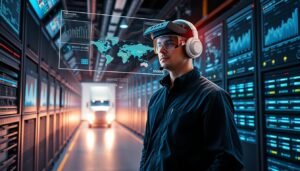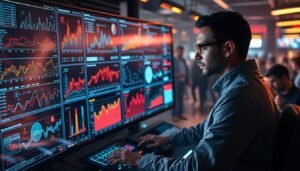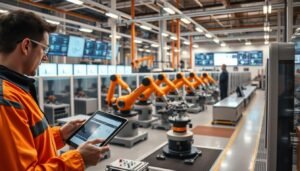Supervised vs Unsupervised vs Reinforcement Learning are the three core types of machine learning that power modern AI systems. Each approach offers unique ways for machines to learn from data, make decisions and improve over time.
Supervised Learning uses labeled datasets to train models to classify data or make predictions. It’s commonly applied in tasks like spam detection, image recognition and forecasting, using algorithms such as logistic regression and support vector machines.
Unsupervised Learning works with unlabeled data, helping algorithms discover hidden patterns or groupings. It’s ideal for customer segmentation and anomaly detection, often using methods like K-Means clustering or PCA.
Reinforcement Learning teaches machines to make sequential decisions by interacting with their environment and learning from rewards or penalties. It’s widely used in robotics, game AI and autonomous systems, leveraging algorithms like Q-Learning.
As these learning methods evolve, they’re transforming industries by enabling smarter automation, deeper insights, and more adaptive technologies.
Key Takeaways:
- Knowing the differences between supervised, unsupervised, and reinforcement learning is key to using AI fully.
- Supervised learning is accurate but needs labeled data and can overfit.
- Unsupervised learning finds patterns without labels, showing hidden data insights.
- Reinforcement learning adapts through interaction but faces complex challenges.
- The right learning model depends on the data and problem at hand.
- Industries use these models based on their data and needs.
Exploring the Vast World of Machine Learning Algorithms:
Machine learning is changing many industries. It’s not just about reacting to problems. It’s about predicting and shaping the future. Neural networks and advanced algorithms turn big data into useful insights.

Data science is key to this progress. It helps process and analyze huge amounts of data. Together, machine learning and data science create powerful solutions for many fields.
How Machine Learning is Transforming Industries:
Healthcare, finance, and robotics are being changed by machine learning. In healthcare, it helps find diseases early and tailor treatments. Finance uses it to predict risks and automate trades. Robotics gets better at automating tasks. This change is thanks to AI getting smarter. Machines can now learn and do more than ever before.
The Role of Data Science in Advancing AI:
Data science is essential for AI to improve. It turns raw data into insights for machine learning models. These models drive innovation and help make better decisions.
As AI becomes more important, so does the use of neural networks. They’re key for tasks like recognizing images and understanding language.
| Year | Global Market Size of AI (in billion USD) | Expected Market Size by 2030 (in billion USD) |
|---|---|---|
| 2023 | 158.880 | 528.10 |
| Annual Growth Rate | 18.73% | |
| Machine Learning Professional Average Salary (USD) | 112,095 – 160,000 | |
The Fundamentals of Supervised Learning:
Supervised learning is key in machine learning. It uses labeled data to help algorithms make accurate predictions. It’s the most used type of machine learning by 2022, shaping tech in many fields.
Understanding Training Data and Model Accuracy:
Training data is at the core of supervised learning. It’s crucial for teaching models to predict outcomes well. A large, well-labeled dataset is needed to train the algorithm. The quality and size of this data affect how accurate the model is. This accuracy is what lets the model handle new data it hasn’t seen before.
Types of Problems: Classification Models and Regression:
Supervised learning deals with two main types of problems. Classification models predict labels, like ‘spam’ or ‘not spam’ in emails. Regression algorithms, on the other hand, predict continuous values, like sales or stock prices. These frameworks are used in many areas. From spam detection to financial forecasting, they help us every day.

| Type of Problem | Applications | Examples |
|---|---|---|
| Classification | Email filtering, Image recognition | Spam detection, Facial recognition |
| Regression | Forecasting sales, Real estate pricing | Stock market analysis, Predictive maintenance |
Supervised learning is used in many areas. For example, companies like Amazon, Netflix, and YouTube use it. They use it to suggest products based on what you’ve liked before. This shows how powerful supervised learning is.
Diving Into Unsupervised Learning Techniques
Unsupervised learning is a key part of machine learning. It helps systems find complex patterns in data without labels. This is different from supervised learning, which uses labeled data. Unsupervised learning is very useful in fields like healthcare, marketing, and finance.
Clustering techniques and principal component analysis are important in unsupervised learning. Clustering finds groups in data. For example, K-Means and Hierarchical Cluster Analysis help businesses find different customer groups based on what they buy.
Principal Component Analysis (PCA) is also crucial. It reduces data size while keeping important features. This makes data easier to understand and work with.
Anomaly detection is another key part of unsupervised learning. It finds unusual data points. This is important for catching fraud in banking and finding problems in manufacturing.
- Clustering: E.g., Market Segmentation
- Principal Component Analysis: E.g., Feature Reduction in Large Datasets
- Anomaly Detection: E.g., Fraud Detection in Financial Transactions
These methods help industries analyze data on their own. They find important insights without needing humans. This makes companies better at making quick, smart decisions based on data.
Introduction to Reinforcement Learning and Its Reward Mechanism:
Reinforcement learning is a unique part of artificial intelligence. It uses methods different from supervised and unsupervised learning. Agents in this learning type act in an environment that changes based on their actions.
They learn from the results of their actions through rewards. This helps them adapt and improve over time. The reward mechanism is key in reinforcement learning. It gives immediate feedback to agents. Positive actions get rewards, while negative ones might not.
This feedback helps agents learn and change their strategies. It’s a way for them to find better ways to achieve their goals. Deep learning is important for reinforcement learning. It gives algorithms the power to handle complex situations. This is crucial for making decisions and solving problems in changing environments.
The Paradigm Shift from Supervised and Unsupervised Models:
Reinforcement learning is different from supervised and unsupervised learning. It uses trial-and-error to learn. This is unlike supervised learning, which relies on labeled data, or unsupervised learning, which looks for patterns.
Reinforcement learning prepares models for real-world challenges. It helps them adapt to new situations. This makes it great for tasks that need quick thinking and problem-solving.
Applications: From Gaming to Robotics:
Reinforcement learning has many uses, from digital to physical areas. In gaming, it has changed how games are played and made. It helps both game AI and players improve their strategies.
In robotics, reinforcement learning gives robots the ability to learn and do tasks on their own. This includes simple household chores to complex industrial tasks. It helps robots work better and safely.
As technology advances, reinforcement learning is changing robotics and gaming. It’s making machines smarter and more interactive. This is a big change in how machines see and interact with the world.
Supervised vs Unsupervised vs Reinforcement Learning Explained:
In the world of machine learning, it’s key to know the difference between supervised, unsupervised, and reinforcement learning. Each method has its own way of working with data. This leads to different results and uses in various fields.
Supervised learning uses labeled data to train algorithms. It uses techniques like classification and regression to make accurate predictions. It’s known for being easy to understand and uses algorithms like Linear Classifiers, GBM and Support Vector Machines (SVM).
Unsupervised learning works with data that isn’t labeled. It finds hidden patterns and structures. It’s great for finding new insights and spotting unusual data points, making it essential for market research and complex systems.
Reinforcement learning is different because it uses a reward system. It learns by trying things and getting feedback. It’s crucial for tasks like self-driving cars and robots, where it adjusts actions based on feedback.
Supervised and reinforcement learning are both structured learning methods. But they are used in different ways. Reinforcement learning is more flexible because it adapts to new situations. Supervised learning relies on fixed data sets.
| Learning Type | Core Mechanism | Common Algorithms | Key Applications |
|---|---|---|---|
| Supervised Learning | Labeled data training | Decision Trees, SVM | Financial forecasting, medical diagnosis |
| Unsupervised Learning | Pattern discovery in unlabeled data | Clustering, Dimensional Reduction | Market segmentation, anomaly detection |
| Reinforcement Learning | Reward-based feedback system | Q-learning, Deep Learning | Robotics, self-driving cars |
In conclusion, knowing the differences between supervised vs unsupervised vs reinforcement learning explained is vital. It helps choose the right machine learning type for each task. It’s about finding a balance between making good decisions and being able to adapt and learn quickly.
Real-World Applications of Supervised Learning:
Supervised learning is changing many fields, solving big problems. It helps in finance and healthcare by using labeled data. This makes algorithms very good at predicting and classifying data.
Impact on Healthcare: Diagnosing Diseases:
In healthcare, supervised learning is a game-changer. It helps predict disease and find treatments early. Algorithms look at patient data to spot things doctors might miss.
Advancements in Finance: Predictive Modeling:
In finance, supervised learning is key for predicting the future. Banks use it to spot risks and predict market trends. It helps prevent fraud by analyzing past behavior.
Natural Language Processing and Its Uses:
Natural language processing (NLP) shows how supervised learning works with language. It does things like understand feelings in text and translate languages. This makes talking to machines better and helps businesses understand what customers say.
| Application Area | Function | Impact |
|---|---|---|
| Healthcare | Disease Diagnosis | Enhances early detection and accurate diagnosis |
| Finance | Credit Risk Analysis | Reduces financial risks and fraud |
| Natural Language Processing | Sentiment Analysis | Improves customer interaction and experience |
Uncovering the Potential of Unsupervised Learning in Various Domains:
Unsupervised learning is key in many fields. It can analyze complex data without needing labels. This lets us find new insights and improve things in many areas.
In e-commerce, market segmentation is a big win for unsupervised learning. It groups customers by their buying habits. This helps businesses make better marketing plans, leading to more sales and happier customers.
In cybersecurity, intrusion detection systems use unsupervised learning to find odd patterns. These systems learn from network data. They get better at catching security threats over time.
Genetics also benefits from unsupervised learning, especially in clustering genes. Scientists use algorithms to group genes by how they act. This helps them understand gene relationships better. It speeds up genetic research and can lead to medical advances.
Here’s a quick look at the differences between unsupervised and supervised learning:
| Aspect | Supervised Learning | Unsupervised Learning |
|---|---|---|
| Data Requirement | Labeled data needs | No labels needed; uses raw data |
| Main Focus | Predictive accuracy | Pattern discovery |
| Common Use Cases | Classification, Regression | Clustering, Anomaly detection |
| Human Involvement | High (data labeling, tuning) | Minimal (decides only algorithm and parameters) |
This comparison shows unsupervised learning’s strength in exploring data. It’s key for making sense of big data.
Unsupervised learning is becoming more important in many areas. It boosts efficiency and drives innovation. It helps industries make better decisions based on data.
As data keeps growing, unsupervised learning becomes more crucial. It helps us find hidden values in big datasets.
Reinforcement Learning: Adapting and Decisive Algorithms in Action:
Reinforcement learning is changing how machines learn and adapt. It works well in changing environments. It uses adaptive algorithms to improve how autonomous systems work.
How Reinforcement Learning Agents Learn Through Interaction:
Agent interaction is key in reinforcement learning. Agents learn by trying different actions and getting rewards or penalties. They don’t need training datasets. Instead, they learn from each interaction.
Deep Learning and Decision Making in Reinforcement Learning:
Deep learning makes reinforcement learning agents smarter. They can solve complex problems better. This mix is called Deep Reinforcement Learning (DRL). It’s helping make autonomous systems better in many areas.
These technologies have many uses. For example, in self-driving cars, reinforcement learning helps them navigate safely. In robotics, it makes them more precise and adaptable.
| Year | Advancement | Application |
|---|---|---|
| 2016 | AlphaGo’s Victory | Game Strategy Development |
| 2019 | MIT Technology Review Acknowledgment | Evaluation of AI Progress |
| Recent Years | Rise of DRL | Industrial Systems, Energy Efficiency |
Reinforcement learning is leading to smarter AI. It’s making AI more capable of making decisions in changing situations.
Case Studies: How These Models Shape Decision-Making and Efficiency:
Machine learning has changed many fields, like healthcare and retail. It has made AI more efficient and helped make better decisions. Here are some examples from different areas, showing how these models work well.
In healthcare, machine learning looks at medical images and patient data. It helps doctors diagnose diseases like cancer and heart issues more accurately. This makes diagnosis faster and care better for patients.
In finance, machine learning helps figure out if someone can get a loan. It uses past data to predict if someone will pay back a loan. This helps banks make safer choices and plan better.
Retail uses both kinds of learning. Supervised learning predicts how many products to stock. Unsupervised learning groups customers so stores can market better to each group. This makes shopping more enjoyable for everyone.
| Industry | Learning Model | Key Outcome | Efficiency Gain |
|---|---|---|---|
| Healthcare | Supervised | Disease Diagnosis | High accuracy, Faster decisions |
| Finance | Supervised | Credit Scoring | Risk mitigation |
| Retail | Unsupervised | Customer Segmentation | Targeted Marketing |
E-commerce and streaming use unsupervised learning for recommendations. They make suggestions based on what you’ve watched or bought. This makes users happier and more engaged.
Unsupervised learning also helps in cybersecurity. It finds threats and oddities without knowing what to look for. This keeps data safe and responds quickly to dangers.
In summary, using both supervised and unsupervised learning in these fields boosts decision-making. It makes decisions smarter, faster, and more effective.
Choosing Between Supervised, Unsupervised and Reinforcement Learning for Your Data:
Starting a machine learning project means picking the right learning style. This choice affects how you train algorithms and use data. It also shapes your model selection.
Factors to Consider When Selecting a Learning Paradigm:
Understanding the different machine learning types is key. You have supervised, unsupervised, and reinforcement learning. Each has its own way of working and needs:
- Supervised Learning: Needs lots of labeled data. It’s great for tasks like recognizing images or spotting spam. This method uses data with the right answers to learn from.
- Unsupervised Learning: Works with data without labels. It finds hidden patterns. Uses like grouping customers by preferences or finding odd data points.
- Reinforcement Learning: Uses rewards and penalties to learn. It’s for tasks where a model interacts with its environment. Examples include self-driving cars or playing games.
Choosing the right learning style depends on your data and problem. This is where picking the right algorithm and learning style is crucial.
Matching the Algorithm to the Problem Type and Data Availability:
Picking the right algorithm is key to a machine learning project’s success. Here’s a simple guide:
- For data with clear labels, supervised learning algorithms are best.
- For data without labels but needing pattern finding, try unsupervised learning algorithms.
- For problems needing to understand environmental interactions, use reinforcement learning.
Also, think about the resources you have. Different methods need different amounts of data, computing power, and knowledge.
The goal is to get the most insights and accurate predictions from your data. Aligning data labeling, algorithm selection, and model selection with your chosen learning style leads to better results in machine learning.
Conclusion: The Power of Diverse Learning in AI
Throughout our exploration of Artificial Intelligence, it’s clear that each learning paradigm—Supervised, Unsupervised, and Reinforcement Learning—offers unique strengths and plays a crucial role in solving real-world problems.
Supervised Learning thrives on labeled data, excelling in predictive tasks such as price forecasting, image classification, or medical diagnosis.
Unsupervised Learning uncovers hidden patterns in unlabeled data, enabling insights through clustering, anomaly detection, and dimensionality reduction.
Reinforcement Learning excels in dynamic, decision-driven environments like game-playing, robotics, and autonomous systems, where learning from interaction is essential.
Understanding the differences and applications of these learning types empowers AI practitioners to select the right tools for the task. While Supervised and Unsupervised Learning help build models from existing data, Reinforcement Learning adds depth by learning from experience, opening new frontiers in adaptive and intelligent systems.
Ethical and Strategic Use of AI
As we harness these learning approaches, it’s essential to emphasize ethical and transparent data use. AI’s potential to transform industries—from healthcare and finance to transportation and retail—relies on responsible implementation.
By strategically applying the right learning type, we enable:
Smarter automation
Deeper insights
Greater innovation
Shaping the Future with AI
These foundational learning types not only define the present landscape of AI but also shape its future. Recognizing when and how to use each method allows us to build intelligent systems that are not just powerful—but purposeful.
FAQ:
What is the difference between supervised, unsupervised and reinforcement learning?
Supervised learning uses labeled data to train algorithms. It helps predict outcomes or classify data. Unsupervised learning, on the other hand, uses unlabeled data to find patterns. Reinforcement learning learns through interaction with the environment, using rewards and penalties.
How are machine learning algorithms transforming industries?
Machine learning algorithms are changing industries by using big data to learn and make decisions. They improve predictive models. This has led to big changes in healthcare, finance, and robotics.
What are the fundamentals of supervised learning?
Supervised learning uses labeled data to train models. It includes classification models for discrete values and regression for continuous values. This improves model accuracy based on the data.
What are some common unsupervised learning techniques?
Unsupervised learning includes clustering methods like K-Means and dimensionality reduction like principal component analysis. It also includes anomaly detection to find unusual data points.
How does the reward mechanism work in reinforcement learning?
In reinforcement learning, an agent gets rewards or penalties for its actions. It learns to take actions that maximize rewards. This helps it achieve its goals.
Can you explain the main differences between supervised, unsupervised, and reinforcement learning?
Supervised learning uses labeled data for predictions. Unsupervised learning finds patterns in unlabeled data. Reinforcement learning learns through environmental interaction and rewards.
What are some real-world applications of supervised learning?
Supervised learning is used in healthcare diagnostics, fraud detection in finance, and customer sentiment analysis. It has many applications.
What potential does unsupervised learning have in various domains?
Unsupervised learning is great for finding hidden patterns. It’s used in customer segmentation, anomaly detection, and gene classification. It’s very useful.
In what ways are adaptive and decisive algorithms used in reinforcement learning?
Adaptive and decisive algorithms are used in autonomous vehicles, advanced game AI, and robotics. They help systems learn and adapt to new environments.
How do supervised, unsupervised, and reinforcement learning models shape decision-making and efficiency?
These models help make better and faster decisions. They lead to greater efficiency. They help businesses and organizations improve by using AI.
How do I choose between supervised, unsupervised, and reinforcement learning for my data?
Choose based on your data type, problem, and desired outcome. Consider the tasks, data, and objectives. This will help you pick the right learning paradigm.
What are the benefits of reinforcement learning?
Reinforcement learning is great for solving problems with decision sequences. It adapts to changes and learns optimal strategies through trial and error with rewards.





















